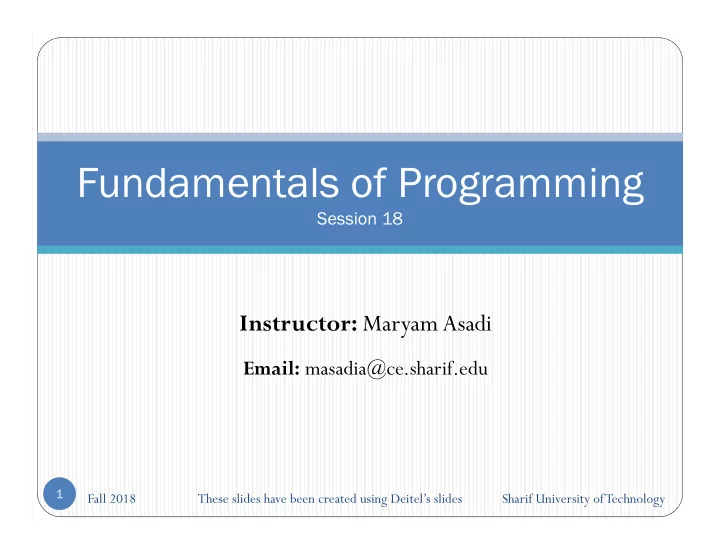

Fundamentals of Programming Session 18 Instructor: Maryam Asadi Email: masadia@ce.sharif.edu 1 Fall 2018 These slides have been created using Deitel’s slides Sharif University of Technology
Outlines Pointers Pointer Operators Passing Arguments to Functions by Reference 2
Pointers Pointers enable programs to simulate call-by-reference and to create and manipulate dynamic data structures, i.e., data structures that can grow and shrink at execution time, such as linked lists, queues, stacks and trees. Pointers are variables whose values are memory addresses. 3
Pointers … Pointers, like all variables, must be defined before they can be used. The definition int *countPtr, count; specifies that variable countPtr is of type int * (i.e., a pointer to an integer) and is read, “ countPtr is a pointer to int ” or “ countPtr points to an object of type int .” Also, the variable count is defined to be an int , not a pointer to an int . The * only applies to countPtr in the definition. Pointers should be initialized either when they’re defined or in an assignment statement. A pointer may be initialized to NULL , 0 or an address. A pointer with the value NULL points to nothing. 4
Pointer Operators The & , or address operator, is a unary operator that returns the address of its operand. For example, assuming the definitions int y = 5; int *yPtr; the statement yPtr = &y; assigns the address of the variable y to pointer variable yPtr . Variable yPtr is then said to “point to” y . 5
Pointer Operators … The unary * operator, commonly referred to as the indirection operator or dereferencing operator, returns the value of the object to which its operand (i.e., a pointer) points. For example, the statement printf( "%d", *yPtr ); prints the value of variable y , namely 5. Using * in this manner is called dereferencing a pointer. Figure 7.4 demonstrates the pointer operators & and * . 6
Pointer Operators … 7
Pointer Operators … 8
Passing Arguments to Functions by Reference There are two ways to pass arguments to a function— call-by-value and call-by-reference. All arguments in C are passed by value. Many functions require the capability to modify one or more variables in the caller or to pass a pointer to a large data object to avoid the overhead of passing the object by value (which incurs the overhead of making a copy of the object). For these purposes, C provides the capabilities for simulating call-by-reference. In C, you use pointers and the indirection operator to simulate call-by-reference. 9
Passing Arguments to Functions by Reference … 10
Passing Arguments to Functions by Reference … 11
Passing Arguments to Functions by Reference … 12
Passing Arguments to Functions by Reference … 13
Question 1 What will be the output of the program? int main() { int i=3, *j, k; j = &i; printf("%d\n", i**j*i+*j); return 0; } Answer: 30 14
Question 2 What will be the output of the program? int main() { char str[20] = "Hello"; char *const p=str; *p='M'; printf("%s\n", str); return 0; } Answer: Mello 15
Question 3 What will be the output of the program? int main() { int ***r, **q, *p, i=8; p = &i; q = &p; r = &q; printf("%d, %d, %d\n", *p, **q, ***r); return 0; } Answer: 8, 8, 8 16
Question 4 What will be the output of the program? int main() { int x=30, *y, *z; y=&x; /* Assume address of x is 500 and integer is 4 byte size */ z=y; *y++=*z++; x++; printf("x=%d, y=%d, z=%d\n", x, *--y, z--); return 0; } Answer: x=31, y=31, z=504 17
Recommend
More recommend